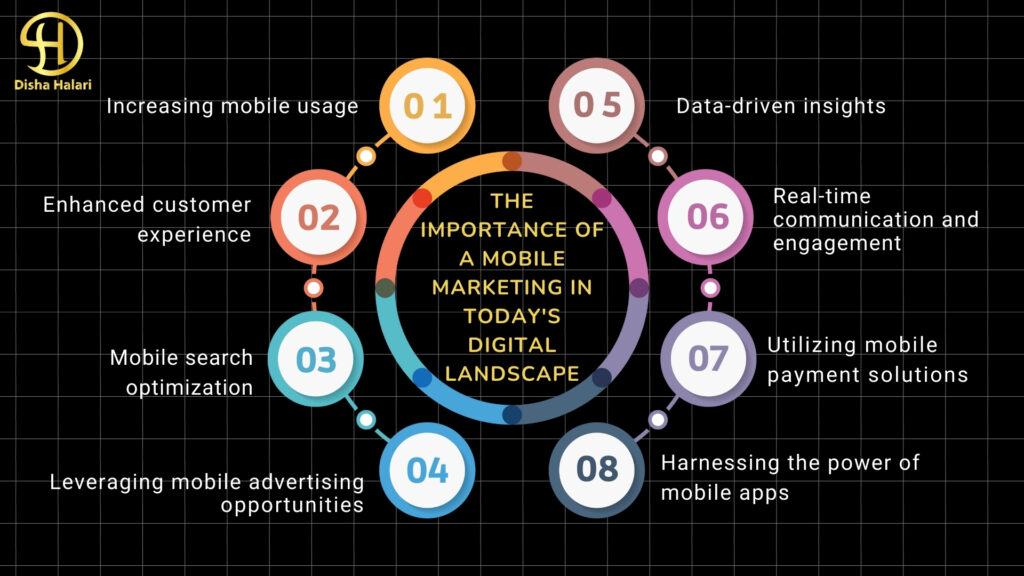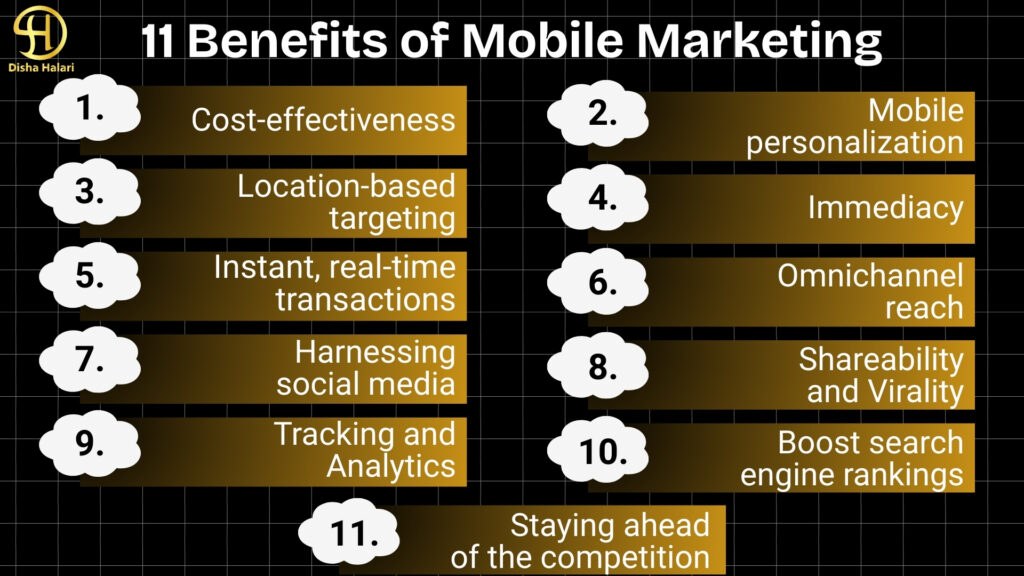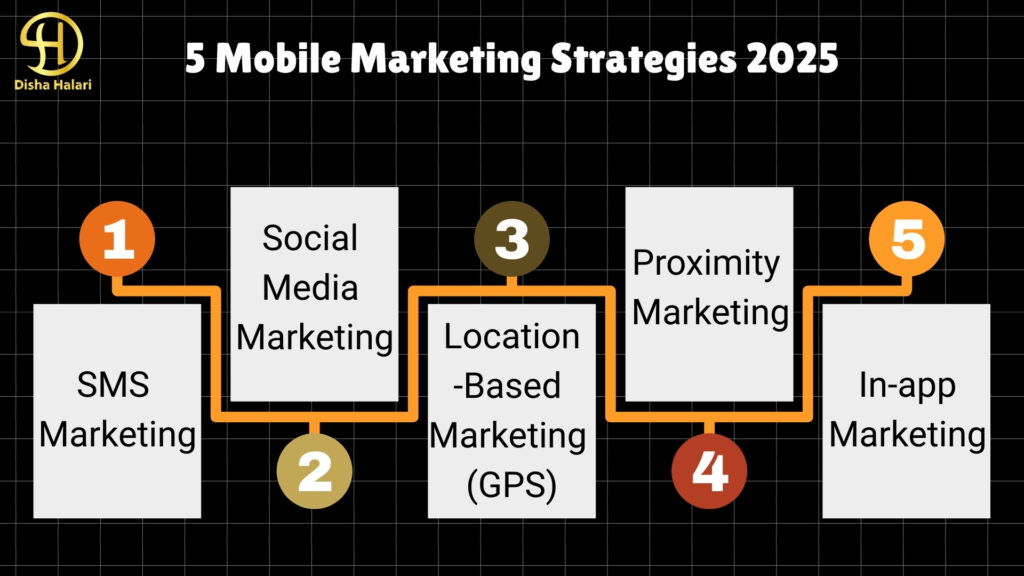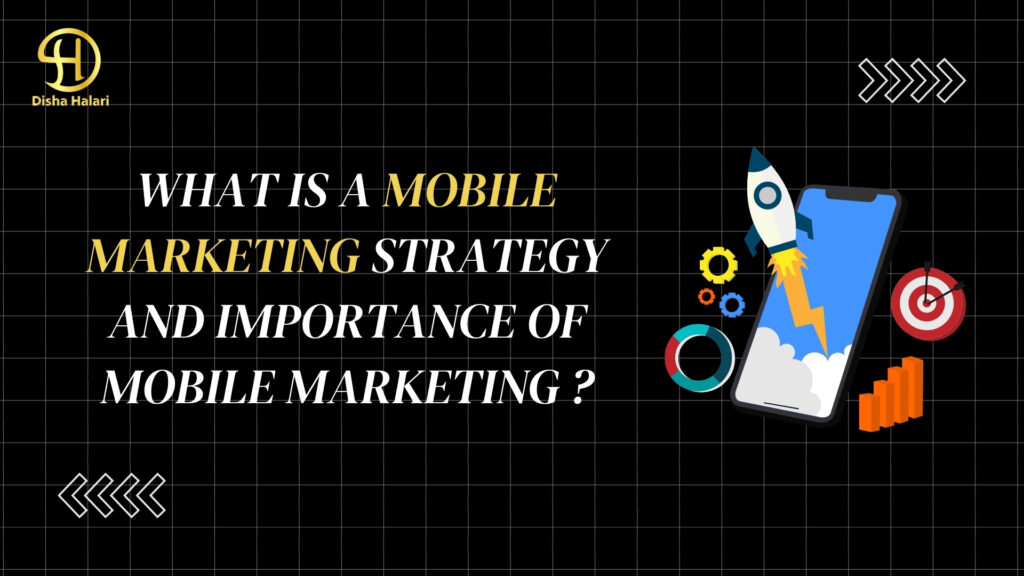Table of Contents
ToggleIntroduction: What Is a Mobile Marketing Strategy and Why Does It Matter Today?
Ever noticed how often you check your phone each day? You’re not alone—and that’s exactly why brands are shifting focus toward a mobile marketing strategy. Simply put, mobile marketing is how businesses connect with people through their smartphones or tablets, using methods like SMS, mobile apps, push notifications, and more. But what is mobile marketing really about? Being where your audience is—on mobile—is the key.
The real importance of mobile marketing lies in its reach and relevance. Whether you’re a startup or an established brand, mobile gives you a direct, personal way to engage your customers. From instant communication to location-based offers, the benefit of mobile marketing is huge.
You’ll also want to know the types of mobile marketing, key features, and the best mobile marketing tools that make campaigns easier to manage. Yes, there are disadvantages of mobile marketing, like privacy concerns, but a well-thought-out mobile marketing strategy in digital marketing agency can outweigh the risks.
In this blog, we’ll explore how it works, what makes it effective, and why mobile isn’t just the future—it’s the now.
What Is Mobile Marketing? An Introduction to the Mobile-First Era
Okay, picture this: you’re standing in line for coffee, and without even realizing it, you’re already on your phone—checking messages, scrolling through social media, maybe even looking up that product you saw on Instagram last night. That’s the world we live in now. Mobile isn’t just a device; it’s where we live, shop, and connect. And that’s exactly where smart businesses are focusing their energy.
Mobile marketing is how brands meet us in those little everyday moments—whether it’s a personalized push notification, a quick-loading ad, or a super relevant offer that pops up while we scroll. In simple terms, it’s marketing designed for phones first. Not laptops. Not desktops. Just mobile.
In 2025, a solid mobile marketing strategy isn’t optional—it’s a must. It’s not about being trendy; it’s about being where people actually are. If you’re not showing up on mobile, chances are… you’re not showing up at all.
Why Mobile Marketing Strategy Matters for Brands in 2025
Let’s not sugarcoat it—2025 is a fast-paced, swipe-right kind of world. People aren’t sitting at desktops waiting for ads to load. They’re on the move, phones in hand, multitasking like pros. So if a brand still thinks old-school marketing is enough, well… it’s probably already getting ghosted by its audience.
A mobile marketing strategy is basically your digital handshake in today’s world. It’s how brands say, “Hey, we see you,” without being annoying or pushy. Whether it’s a slick SMS deal, a perfectly timed push notification, or a smooth in-app ad, it’s all about catching your audience right in the moment. On the bus. At lunch. While they pretend to listen in a Zoom meeting.
The beauty of mobile? You’re not waiting for people to come to you—you’re stepping into their world. And if you do it right? You build trust, stay top-of-mind, and keep them coming back. So yeah, if you’re a brand looking to actually connect (and not just shout into the void), mobile marketing isn’t just important—it’s everything.
The Importance of Mobile Marketing in Today’s Digital Landscape
Let’s face it—if your business isn’t on mobile, it’s kind of like having a store with no signboard. People just scroll past. In today’s world, everything’s happening through a screen that fits in your hand. From ordering food to buying sneakers to booking appointments—mobile is the front door to your brand.
So, when we talk about the importance of mobile marketing, we’re not talking theory. It’s survival. Mobile gives brands the chance to be present exactly when people are ready to act. It’s fast, personal, and—most importantly—it meets users where they’re comfortable.
Plus, with mobile, you’re not just blasting out ads. You’re building experiences. Think interactive stories, one-tap purchases, personalized offers—it’s all about making the user feel like, “Hey, this was made for me.”
Honestly, if your brand isn’t using mobile marketing in 2025, you’re not just behind. You’re invisible. Mobile isn’t a side strategy anymore—it’s the main one. Simple as that.

Types of Mobile Marketing You Should Know in 2025
Alright, mobile marketing isn’t just one thing—it’s more like a toolkit with different tools, each one doing its own job. And in 2025, if you want your brand to actually stand out, you’ve gotta know which tool to use and when.
Let’s break it down:
SMS marketing is still a champ—short, snappy texts that land right in your customer’s pocket. Then there’s in-app marketing, which is like whispering into someone’s ear while they’re using your app. Super direct.
You’ve also got push notifications—quick reminders or alerts that can bring people back, especially when timed right.
And don’t forget mobile-friendly emails—yep, emails are still alive and well, but only if they’re readable without squinting.
Now toss in social media ads made for mobile scrolling (Instagram Reels, TikTok, stories, all that jazz), plus location-based marketing that targets people based on where they are. Creepy? Maybe. Effective? Definitely.
Bottom line: the types of mobile marketing out there are growing fast—and knowing how to mix them is key to keeping your audience locked in.
Top Features of Mobile Marketing That Drive Engagement
Okay, let’s be real—nobody wants to be blasted with ads they didn’t ask for. Mobile marketing completely alters the game in this situation. It’s not about throwing stuff at people and hoping it sticks. It’s about actually connecting.
One of the biggest things people love? Getting stuff that feels personal. Like when a brand remembers your name or sends you a deal for something you were literally just thinking about—creepy? A little. But also super effective. That kind of personalization keeps people interested.
Another standout? Timing. Mobile marketing hits you right when it matters. Flash sale? You get a push notification. Near your favorite store? Boom—location-based alert. It’s quick, convenient, and it works.
Also, mobile makes everything easier. Click to buy. Tap to call. No jumping through hoops.
At the end of the day, the features of mobile marketing make people feel seen and save them time. And let’s face it, we all desire that.
Benefits of Mobile Marketing: Why It’s a Smart Business Move
Let’s keep it real—our phones are basically glued to our hands. That’s why mobile marketing works so well. It meets people right where they are, without interrupting their day too much.
Say you’ve got a sale going on. Instead of hoping someone checks their inbox, you send them a quick message that pops up right on their screen. Easy, fast, and super effective.
Another win? It’s cheaper than running big campaigns. You don’t need a fancy setup. A simple push notification or SMS can actually get better results than a flashy ad.
Plus, you can get super personal. Like, “Hey Sam, here’s 15% off that jacket you liked.” Feels friendly, not salesy.
Bottom line: mobile marketing helps businesses stay close to customers without being annoying. It’s low-cost, fast, and honestly—pretty smart.

Key Advantages of Mobile Marketing for Customer Growth
Mobile marketing is one of those things that just makes sense in today’s world. Everyone’s glued to their phone, and it’s the best way to stay connected with customers in real-time. What makes it so special is how personal it can be. You can send people offers, updates, or content that’s tailored to them, right when they need it.
Imagine you’re shopping online, and a store you love sends you a coupon on your phone while you’re nearby — that’s mobile marketing at its best! It’s also super convenient for businesses because you can reach people wherever they are, whether they’re at home, out on the go, or even at work. And when a smart digital marketing company uses geolocation features to send hyper-targeted messages, your marketing starts to feel way more relevant. Done right, it doesn’t just increase engagement; it builds real loyalty and drives serious growth.
Mobile Marketing Strategy in Digital Marketing: A Perfect Match
If you’re running a business today, it’s hard to ignore mobile marketing — especially when it’s part of your bigger digital marketing strategy. We all know people are spending a ton of time on their phones, so it’s only natural to meet them where they’re at. When mobile marketing is blended with your SEO and social media strategy, it just clicks.
Think about it: when someone visits your website on their phone, it should be smooth and easy to navigate. And while they’re there, you can pop up a helpful ad or a push notification that speaks directly to their needs. Plus, having a cohesive strategy means your message stays consistent no matter how or where your customers find you. The better integrated your mobile strategy is with everything else, the more it feels like a natural part of the customer journey.

Mobile Marketing Tools That Help You Reach the Right Audience
Reaching the right audience on mobile isn’t as hard as it sounds, especially with the right tools.
Google Ads and Facebook Ads are great for narrowing down exactly who you want to target — whether it’s people in a specific location, those with certain interests, or even just your past website visitors. SMS marketing tools like Twilio let you shoot out texts directly to people’s phones, and they can be super effective when done well (who doesn’t check a text within minutes?).
You can also use email marketing tools like Mailchimp, which let you create emails that look amazing on any mobile device. There are even tracking tools, like Google Analytics, that show you how your audience is interacting with your content, so you can make adjustments in real-time and get better results. The goal? Make sure your message lands where it needs to, in the most efficient way possible.
How to Work Mobile Marketing Effectively in 2025
Making mobile marketing work in 2025 is all about making things personal and relevant. People don’t want to see generic ads anymore; they want something that speaks directly to them. That’s why it’s important to understand your audience’s habits, what they click on, and when they engage with your brand.
It’s also essential to optimize everything for mobile — from your website to your ads, emails, and even your content. If it takes forever to load or doesn’t look good on a phone, your audience is going to bounce.
In 2025, you’ll also see more creative mobile ads, like interactive ones or even AR ads. And as voice search becomes more popular, you’ll need to optimize for it too, making sure your content answers the types of questions people would ask out loud. Don’t forget about privacy either — customers care about how their data is used, so always be transparent about it.
Disadvantages of Mobile Marketing: What to Watch Out For
Even though mobile marketing has a lot of perks, it’s not all smooth sailing. One big challenge is the limited screen size — it’s tough to convey a complex message when you’ve only got a few inches of screen space to work with. Then there’s the issue of ad fatigue.
People are constantly getting pinged with notifications and ads, so your message can easily get lost if it’s not engaging enough. Tech problems can be another headache. Mobile users expect apps and websites to work seamlessly, and if things crash or don’t load properly, you risk frustrating your audience.
Privacy concerns are huge, too. With all the data you’re collecting, it’s important to be clear with customers about how their info is being used. Lastly, timing matters — if you’re sending an ad at the wrong time, it can feel intrusive and push people away. It’s a fine line, but with a thoughtful approach, you can minimize these issues.
Conclusion: Balancing the Pros and Cons of Mobile Marketing
Mobile marketing is super powerful, but it comes with its fair share of challenges. The key is finding that balance between making the most of its benefits — like real-time engagement and personalization — while also being mindful of the downsides.
Yes, small screens can be tricky, and tech glitches happen, but when done right, mobile marketing allows you to build deeper relationships with customers. If you keep things relevant, personalized, and user-friendly, your mobile strategy can be a game-changer for your business.
It’s all about staying tuned in to what your audience wants and respecting their time and privacy.
F.A.Q. mobile marketing strategy & importance of mobile marketing
Q1: Who introduced mobile marketing?
Mobile marketing didn’t come from one person but evolved alongside advancements in mobile technology. In the late 1990s and early 2000s, companies like Coca-Cola and Nokia began testing SMS-based campaigns. The concept gained traction when mobile apps and smartphones gained popularity, with Google and Apple integrating advertising platforms that allowed brands to target mobile users. As smartphones became integral to daily life, businesses recognized the power of reaching customers on-the-go, leading to the broader adoption of mobile marketing strategies we see today.
Q2: How successful is mobile marketing?
Mobile marketing has proven to be extremely successful. It’s one of the most effective ways to reach customers, with over 5 billion smartphone users worldwide. The high engagement rates of mobile users—often checking their phones dozens of times a day—make it an ideal platform for businesses to promote products, send real-time offers, and increase brand visibility. Studies show mobile ads generate higher click-through rates compared to desktop ads. Brands that use mobile marketing effectively experience better customer retention, conversions, and ROI, making it essential for modern marketing strategies.
Q3: How many types of mobile marketing are there?
Mobile marketing encompasses several strategies, including SMS (text messaging), MMS (multimedia messaging), push notifications, in-app advertising, and location-based marketing. Each approach targets users differently. SMS and MMS are direct ways to communicate, while push notifications help brands engage customers with timely messages. In-app ads are shown within apps users already engage with, and location-based marketing uses GPS to offer real-time, personalized offers. These methods ensure that businesses can connect with consumers in a way that suits their preferences and behavior, making mobile marketing versatile and effective.
Q4: What is the impact of mobile marketing?
The impact of mobile marketing has been transformative for businesses. With the constant use of smartphones, companies can now reach their customers in real-time, delivering highly personalized and relevant content. The ability to track user behavior and preferences has made mobile marketing a highly effective tool for targeting and engagement. Moreover, mobile marketing has led to higher conversion rates, improved customer loyalty, and more efficient advertising spend. It also fosters deeper customer relationships by offering value through tailored messaging, which significantly enhances brand visibility and customer retention.
Q5: How to create a mobile marketing strategy?
Creating a successful mobile marketing strategy involves understanding your audience’s behaviors and choosing the right channels to connect with them. Start by analyzing your customers’ mobile usage patterns, preferences, and which devices they use. Then, craft tailored messages through SMS, push notifications, or in-app ads. It’s essential to ensure your website and landing pages are optimized for mobile devices, as a seamless user experience increases conversion rates. Lastly, track and analyze performance metrics to refine your strategy, ensuring your campaigns become increasingly effective over time.
Q6: What is the concept of mobile marketing?
Mobile marketing is a strategy used by businesses to reach consumers via mobile devices like smartphones and tablets. It includes various tactics like sending SMS promotions, delivering app-based ads, and leveraging location-based targeting. The goal is to engage customers where they are most active—on their mobile devices. Mobile marketing is effective because it provides timely, relevant, and personalized messages that connect with users in real-time. By utilizing mobile marketing, brands can increase visibility, enhance customer engagement, and drive sales, making it an essential tool in modern marketing.
Q7: What is the scope of mobile marketing?
The scope of mobile marketing is vast and expanding. With over 5 billion people globally using smartphones, businesses have an unparalleled opportunity to reach a massive audience. Mobile marketing spans a range of techniques, including SMS, push notifications, in-app advertising, and location-based marketing, each offering unique ways to connect with consumers. As mobile technology advances, the scope of mobile marketing continues to grow, incorporating new features like augmented reality, voice search, and AI-driven targeting. This expansion ensures that businesses can adapt their marketing strategies to new trends and consumer behaviors.


